Ask A Gear Guru: How Long Do Running Shoes Last?
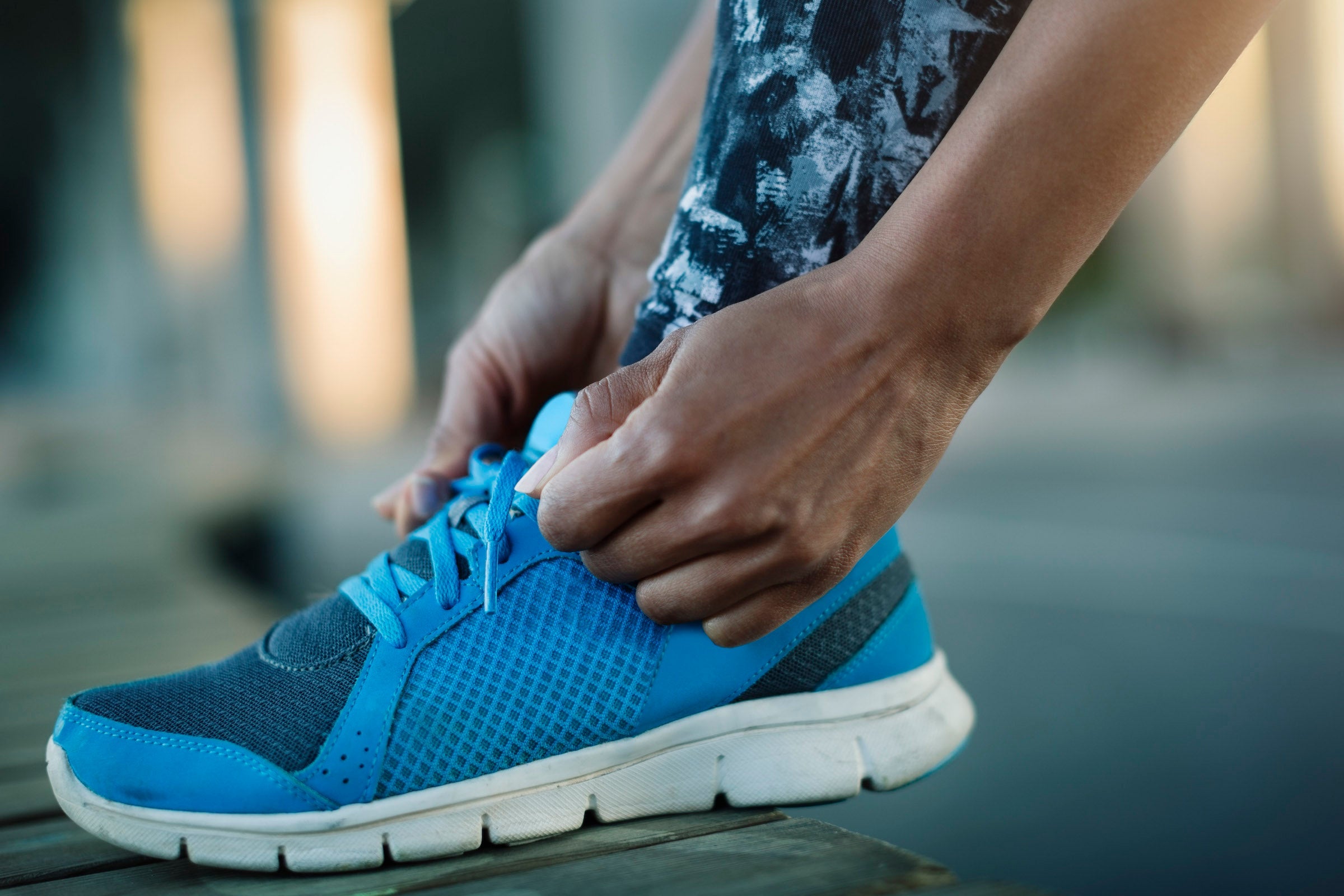
(Photo: Getty Images)
If you think about it, running shoes are one of the best things you can spend your money on.
For the $100-$200 you spend (yes, there are models that cost a lot more), you’re making a huge investment in your fitness for the next four to eight months. But it’s a bit of a paradox, too, because there’s the notion that the more you run and the healthier you get, the quicker your shoes wear out and the sooner you’ll need to buy a new pair.
How long should your running shoes last? There’s a general understanding that most pairs will last between 350 and 500 miles, but it depends what kind of running you’re doing and many other factors, says Sonya Estes, owner of the Runner’s Roost shop in Lakewood, Colorado.
Those are just estimates, but it’s important to realize foam midsoles, synthetic fabrics, rubber outsoles, and even laces can begin to break down after about 200 miles.
In recent years, Estes says she’s seen a trend of some shoes lasting longer or wearing more evenly, in part because there are fewer shoes with dual-density support on the medial side. But, she admits, all shoes do eventually break down and running too long in shoes that are showing signs of wear can lead to changes in your gait, less protection for your feet, general discomfort, or overuse injuries, she says.
“It’s one of those things where some people think it’s a certain amount of mileage and others think it’s a set number of months, so we tell them to come back after a few months to see how they’re doing,” she says. “And with some of the better rubber outsole materials from Vibram and Continental, some of the shoes will last longer than that. So it really depends on the runner and the shoe.”
Even with that runner/shoe variability there are still some things you can do to make your shoes last a little bit longer. Here are some tips to get the most of your kicks.
RELATED: Where to Donate Your Old Tri Gear
Wear Your Shoes Only for Running
A lot of running shoes look good with jeans and can complement a casual outfit. But it’s best to avoid wearing your running shoes for anything but running. Wearing your running shoes as everyday shoes for walking the dog, errands, or mowing the lawn will change the wear patterns of your shoes, reduce the life of the shoes, and ultimately alter your gait slightly and possibly lead to undue soreness or overuse injuries.
Keep in Mind That Your Racing Shoes are Especially Fragile
Featherweight “super shoes” built for racing half-marathon and marathons have a much shorter shelf life because the midsole foam materials are more delicate. They just can’t endure a lot of miles. If you save those shoes for race day, you could get four to five races in them. But if you’re also using them for long runs or up-tempo workouts, they might be cooked after about 250-300 miles. Keep in mind that super shoes also come at a higher price than your typical trainers, so you’re getting even fewer miles for your dollar.
Develop a Quiver of Shoes
Try to avoid running in the same pair of shoes every day. Instead, rotate between two or more different models each week depending on the type of running you’re doing and the surface you’re running on. For example, you might wear a cushier pair of shoes for longer runs or recovery runs and a lighter, firmer shoe for faster workouts such as tempo runs, fartlek runs, and intervals. Rotating shoes during the week will not only extend the life of each pair but also engage the smaller muscles in your feet and lower legs differently and help you avoid overuse injuries. Also, avoid wearing your road running shoes while on running technical trails with rocks and other debris to preserve their outsoles; conversely, super sticky, knobby trail outsoles can wear down faster on pavement than you might want.
RELATED: The 21 Best Running Shoes For Every Kind of Run
Take Care of Your Shoes
Running shoes are only as good as you treat them. Rinsing your shoes with a hose or under the faucet after running through mud or finish a hot, sweaty run will help reduce wear and tear. Speed the process of drying wet shoes by stuffing them with newspapers or dry washcloths or briefly setting them in the sun, but never put shoes in a dryer. Also, keep your shoes indoors but not in your car or garage, where extreme hot or cold temperatures can have a temporary or permanent effect on the materials and how the shoe performs.
Don’t Slide Them On and Off
Take a moment to properly put your shoes on before a run. And don’t take off your running shoes by stepping on the back of one shoe with the other and pulling your foot out without untying the shoe. Not only does it strain muscles in your feet, but it stretches materials of the shoe. The only thing worse than removing your shoes without untying them is putting them back on without untying them. It may seem like a time-saver, but if you put them on with the laces still tied, you’ll strain your foot to squeeze it back in and impair the shoe’s shape.
Recognize the Signs of a Fatiguing Shoe
There are plenty of tell-tale signs that will suggest you’re ready to retire a pair of shoes and go shopping for another pair. The first are indications of obvious signs of wear and tear of the outsole tread or the mesh upper. If you feel like your shoes have lost their bounciness or liveliness and no longer put a spring in your step, it could mean the midsole foam has compressed and has lost its ability to fully rebound.
Lastly, if you start to get unusual aches or soreness from a pair of shoes you’ve been running in for a while, it likely means that the shoe is broken down to the point of no return.
Retire Your Shoes
As much as we have all developed a runner crush on our favorite shoes, there’s only so long you can hang on to some relationships. When you retire a shoe, you should permanently take it out of your running rotation even if you keep it around as a casual shoe or the shoe you wear to do yard work. (You should still avoid walking long stretches in those shoes because whatever wear patterns you’ve worn into those shoes could lead to irregularities in your gait and cause achiness in your knees or hips.)
For the sake of environmental responsibility, try to avoid tossing your shoes in the trash. There are many organizations that will give your shoes a new life so they don’t have to wind up in a landfill, including One World Running, Share Your Soles, and Shoe4Africa.
Below we’ve selected four top picks from Cory Smith, Lisa Jhung, and Jonathan Beverly as a part of Outside Run’s big (and awesome) 2024 running shoe roundup to help replace your tired kicks:
Some of Outside Run’s Top Picks for 2024
Best All-Around: New Balance Balos
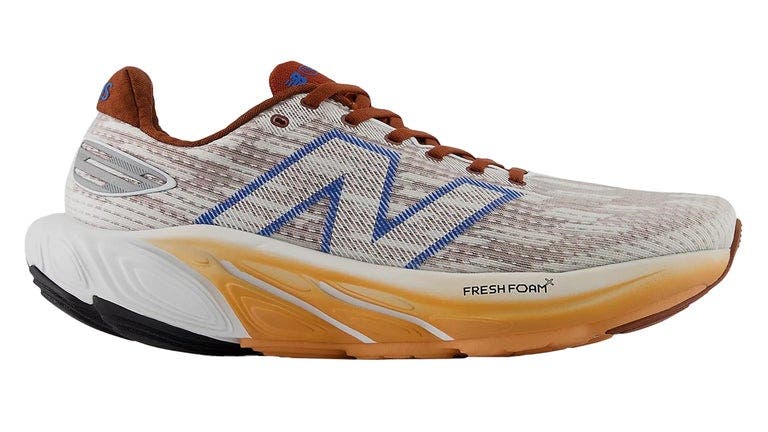
MSRP: $200
Weight: 9.2 oz (men’s), 7.3 oz (women’s)
Drop: 6 mm
The New Balance Balos is that rare diamond that every tester gave glowing reviews. One tester boldly called the Balos “the best premium training shoe ever made,” adding it “offers a unique combination of a light, flexible, soft, responsive cushioning and a rocker that promotes speed and comfort on uptempo runs.”
The secret to its success is the thick stack of ultra-soft and hyper-responsive PEBA midsole foam with a dramatic heel-to-toe rocker profile that facilitates a smooth roll and forward propulsion. The foam, said one tester, is “well-balanced—soft and responsive, providing comfort, structure, and a bit of bounce without feeling overly squishy.” One might think this much foam underfoot would feel numbing, yet the Balos retains a surprisingly flexible forefoot with good ground feel.
The plate-less, flexible midsole let the thick sole work with our feet rather than dictating movement paths or creating an unstable platform. Gear editor Jonathan Beverly, who usually prefers lower-stacked shoes, noted, “The foam adapted to my changing foot shape and moved with me, making it feel like I was enveloped by the sole rather than just standing on it, with no hint of instability to either side.”
Testers unanimously agreed that the Balos offered impressive pace versatility—from slow, easy runs to threshold efforts, even serving as a race-day shoe for some. One tester noted, however, that at 10K pace or faster the midsole seemed to take too much time to compress and rebound, making push-offs sloppy.
Complementing the plush underfoot feel is a comfortable creel mesh upper that’s highly breathable. Another tester noted that the nicely padded tongue and heel collar make it “easy to lock down the laces on the Balos and secure your foot for maximum comfort during your run.” With its well-cushioned underfoot feel and peppy persona, the New Balance Balos won over our most finicky testers, even ones who had sworn off max-cushioned models, to earn best all-around honors.
Best Lightweight Trainer: Under Armour Velociti 4
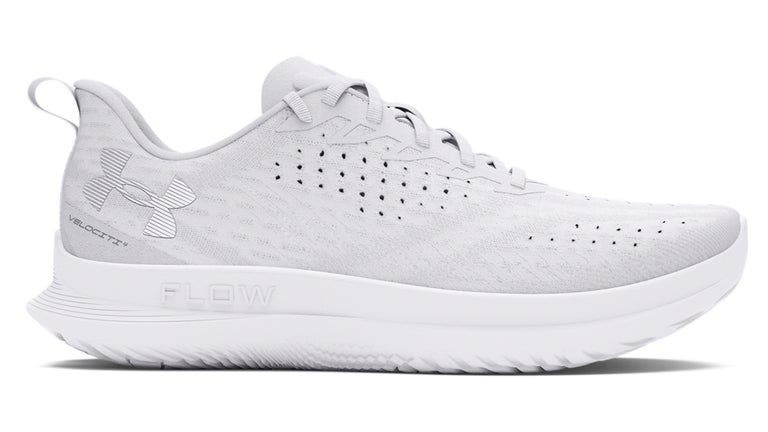
MSRP: $130
Weight: 7.7 oz (men), 6.9 oz (women)
Drop: 8 mm
With the absence of rubber on the outsole and a clean, smooth upper, this shoe just looks lightweight and comfortable—and it is. Testers commented on its immediate comfort—one even wore it on a 10-mile road run out of the box and reported zero hot spots. The knit upper morphs around a range of foot shapes, while the heel collar securely holds our feet for a secure ride.
The shoe’s ride is low and firmly responsive, at least compared to most in this era of oversized, high-cushion midsoles. But the lively cushioning, combined with a flexible outsole (again, no rubber, just exposed UnderArmour FLOW foam), had us enjoying how the Velociti 4 gave us a feel for the ground beneath us, in a springy, connected way.
One tester raved about this shoe’s capability during 400-meter repeats on a rubber track: “The lightness of the shoe, the great fit, and the sole seemed to combine to pull out my best form and let me get in a great groove for a track workout,” she said. Another brought two pairs of shoes to test on a trip to Chicago—these and a more cushioned model—and never wore the other because the Velociti 4 put such a pep in his step while darting nimbly through pedestrians on the River Walk and striding out on the lakefront.
Best Overall Super Shoe: On Cloudboom Strike
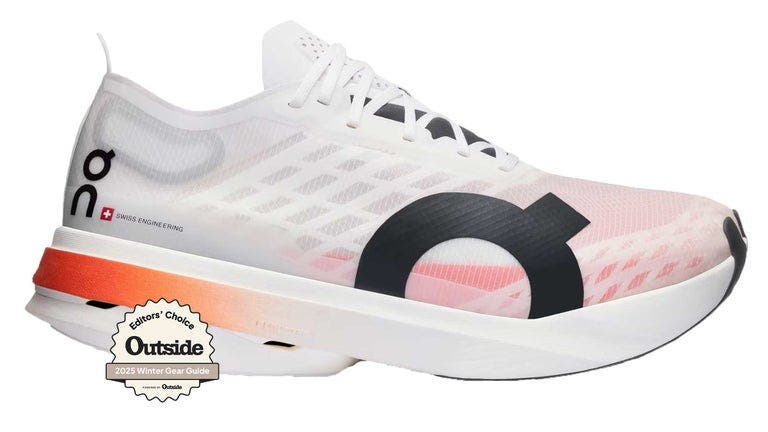
MSRP: $280
Weight: 7.7 oz (men’s), 6.6 oz (women’s)
Drop: 4 mm
Restricted by the 40-millimeter stack height limit set by World Athletics (and followed by most tri federations), On’s engineers stripped away all non-essential elements to maximize the amount of their ultra-bouncy PEBA foam, Helion HF hyper underfoot. Inside, instead of a traditional flimsy insole, there’s a removable thick layer of PEBA foam resting directly on the carbon fiber plate. Plus, the upper is stitched directly onto the plate, eliminating the need for a strobel board. The result is more high-performing foam in the same 40-millimeter stack, which delivers a plush, cushioned feel and gives the impression of more thickness than there actually is.
The shoe is remarkably versatile in terms of pace range, as our lead tester found out during a 5k race. Often, thick-soled super shoes can feel bulky and cumbersome at faster paces. Not the Cloudboom Strike. The shoe cycled through his gait with ease, responding at the drop of a hat when needed. The ride felt equally comfortable on easy runs, marathon pace workouts, and tempo efforts. And, despite weighing roughly the same as many competitor super shoes, the Cloudboom Srike feels lighter on the run, almost as if it’s not there.
The thin, flexible, one-piece mesh upper is comfortable and repels moisture well. A sewn-in overlay cage system, attached to thin, sticky laces, makes it easy to dial fit and ensure your foot is firmly situated in the driver’s seat. Note the fit is long, enough that it’s worth considering sizing down half a size.
Like most super shoes, the Cloudboom Strike isn’t immune to instability issues. The tall stance and soft underfoot feeling can feel wobbly at times, particularly for beginner runners who spend more time on the ground.
Best Cushioned Trainer: Asics Superblast 2
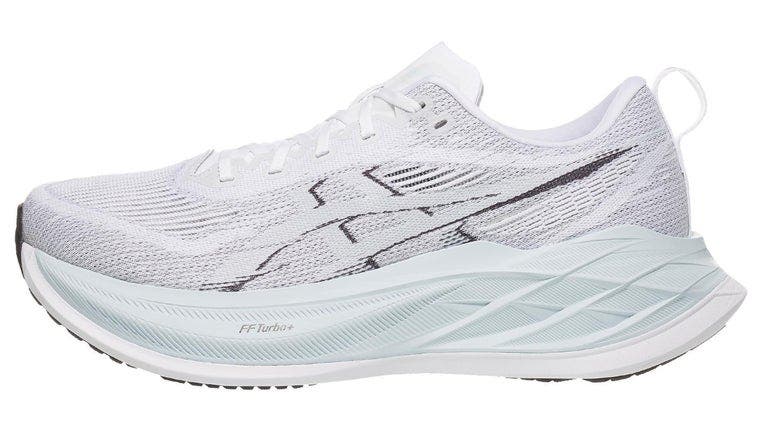
MSRP: $200
Weight: 8.8 oz (unisex)
Drop: 8 mm
It’s clear there’s a growing trend in running shoes: the more cushioning, the better. The Asics Superblast 2 completely leans into this notion. Sporting a whopping 45 millimeters of foam under the heel, not only did Asics not skimp on the amount, but they went with two layers—softer over firmer—of their highest-performing PEBA foams.
One tester called the foam combo “fantastically well engineered and executed,” while another said, “very few shoes offer such a lightweight, stiff, stable, highly cushioned, and super-responsive running platform.” The ride is every bit as lively as it is plush. Despite lacking a plate, the Superblast 2’s soft midsole doesn’t feel mushy and offers a surprisingly sturdy platform, thanks to its wide base.
Testers appreciated the stable ride but found the wide, relatively stiff sole made their gait feel clunky when turning over faster. “Its bulk and rigidity numb my proprioception and hold back my performance,” said one tester about attempting to run fast in the shoe. Runners who like a more sensitive, flexible ride should look elsewhere.
Right out of the box, the Superblast 2 fit true to size for all our testers, with one noting it had “plenty of forefoot room and excellent midfoot lockdown.” The stretchy woven upper and padded heel counter provided ample comfort for even the longest runs, all while keeping us cool.